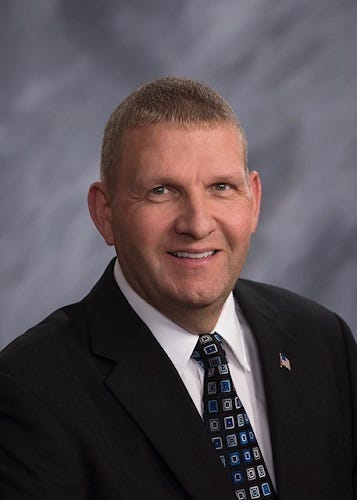SPECIAL SESSION VIEWPOINTS | Lawmakers make final pitches ahead of $650M prison votes
Guest opinion editorials by Reps. Reisch, Wittman & Schaefbauer
Lawmakers return to Pierre next week for a special session at the state Capitol to cast votes on a long-debated proposal to build a new prison in southeast South Dakota.
And with a price tag assured to be the most expensive government project in state history, it’s stirred months of sharp debate — from those who say a new prison to replace the state penitentiary is long overdue to critics who question its price tag and the process behind it.
In advance of the vote, three members of the South Dakota House of Representatives share their perspectives. Read their guest columns below:
POINT | Let's get the prison done
By Rep. Tim Reisch
Next week, the State Legislature will be meeting in special session to consider the plan for a new state penitentiary.
It’s no secret that I have opinions on the South Dakota Department of Corrections. I served as Secretary of that department for nearly a decade, then again as Interim Secretary just a few years ago. And I’ve been vocal in my thoughts on the management of DOC over the last few years. With leadership changing at DOC, though, I am, one hundred percent, behind getting a new prison built.
Gov. Larry Rhoden asked me to be part of the prison task force because he recognized my experience in this area. Yes, we need to make changes in how we handle inmates – both from a rehabilitation and a security standpoint. But those kinds of changes will be far easier to make at a new, modern, state penitentiary.
I care about our correctional officers. I care about their safety, and I worry about their ability to adequately manage rowdy inmates in a deteriorating building that is not laid out for optimum security. Truth be told, I care about the inmates, too – about making sure that they get rehabilitated to rejoin society without returning to prison. The vast majority of our inmates will be back on the streets of South Dakota, most of them within a year or two. We need those individuals to be truly rehabilitated while they’re in prison. We want them to become productive citizens – and we don’t want them coming back to prison.
The new prison will be laid out in a far more secure manner – that’s good for both staff and inmates. It will more than triple the amount of programming and vocational training than what is in the current penitentiary, and that’s how we get inmates on a better path.
A lot of people have questioned the price or falsely claimed that it’s a “billion-dollar prison.” That’s just not true. But we need to stop kicking the can down the road. We have a very good idea of the costs, because we had already bid out the work for the previous plan. The task force made sure that this facility will be built in a fiscally responsible fashion, and the plan that’s in place achieves that without cutting corners on security or quality.
We have a good site. We have a good plan. We have the money to pay the cost, without borrowing. From my seat in the House of Representatives, I’ll be voting yes, and I’ll be asking my colleagues to do the same. Now is the time to get this done and put the conversation to rest.
Rep. Tim Reisch represents the 8th District in the South Dakota House of Representatives. He serves as South Dakota Secretary of Corrections from 2003 to 2011, then as Interim Secretary of Corrections from 2021 to 2022. He also served as Adjutant General of the South Dakota National Guard from 2011 to 2019.
COUNTERPOINT | Wrong time for wrong prison plan
By Rep. Brandei Schaefbauer
South Dakota’s resources, whether rare earth minerals in the Black Hills, our water, our land, our air, or our wide-open spaces, belong first and foremost to the citizens of our great state.
Our growing challenge in this era of political transition is to preserve the quality of life for the people of South Dakota, and to protect those resources from being brokered out from under us to corporate interests, with our elected leaders serving little more than auctioneers to the highest bidder.
During the 2025 legislative session, vast numbers of our constituents and their elected representatives rejected this prison project. Not once, but twice.
Being dragged needlessly to an expensive special session for another manipulated vote speaks to both underhanded tactics and a mysterious urgency that is frequently indicative of unarticulated objectives. Goals and motivations that are hidden from the South Dakota taxpayers, with a list of unanswered questions almost as long and large as the price tag.
After voting down this monstrosity — again, not once but twice — I remain firmly opposed to not only the project itself, but to a process dripping with bad faith from start to finish.
From the Legislature’s 2023 rejection of a plan that would have increased funding and prisoner capacity for county jails, to blanket refusal to consider less costly options of renovation and expansion of existing facilities, state leadership has seemed obsessively fixated on the new, “bigger, better” and outlandishly more expensive prison project while rejecting even cursory remedies to South Dakota’s future corrections needs. And there’s a recent parallel. When all other therapeutic options are removed from the menu of possible solutions, what remains is the most drastic and sometimes, quite harmful final prescription. Pushed by agenda. Immune from debate. We’ve seen this model before.
After two years of incompetent and dysfunctional corrections system leadership, questions must be asked: Were the problems inside South Dakota’s prison facilities the products of bad leadership or were they part of the intentional sales pitch for the most expensive budget line item in our state’s history?
Are lawmakers and our chief executive really interested in building for South Dakota’s future corrections needs or are they simply exploiting a crisis moment caused by a now discarded corrections secretary to justify the massive expenditure and increased burden on the South Dakota taxpayers?
Not only do I promise to vote NO for the third time on this project, as of today, I am calling on my fellow lawmakers to do the same. Beyond that, I believe we should all be questioning the necessity of this upcoming special session pushed by an administration that simply will not take no for an answer. I believe I have heard the clear voice of my District 3 constituents and many other voices from around the state in opposing this project.
Wrong project. Wrong price tag. Wrong time.
Rep. Brandei Schaefbauer serves in the South Dakota House of Representatives. She has represented South Dakota’s 3rd legislative district since 2023.
VIEWPOINT | Build dignity, not just prisons
Rep. Kadyn Wittman
As a state legislator, I believe good policy doesn’t start in a committee room. It starts in the communities we serve. That’s why I was honored to participate this year in the Criminal Justice Reform Innovation Fellowship, a bipartisan learning initiative that brings lawmakers together with directly impacted communities, researchers, and practitioners to explore evidence-based solutions in criminal justice.
Last week, that learning took me to Philadelphia. Alongside fellow legislators from across the country, I had the chance to tour SCI Chester, home to a remarkable initiative known as Little Scandinavia. What I saw there challenged and inspired me. It is something worth South Dakota’s attention.
Little Scandinavia is a reimagined prison unit designed in partnership with corrections leaders from Sweden and Norway, and led by researchers at Drexel University and the University of Oslo. The project is rooted in a radical idea: that rehabilitation, dignity, and trust can form the foundation of a safer and more just system.
Inside, we toured cells designed with privacy and humanity in mind, not punishment. There were communal kitchens, outdoor spaces, and programming centered on education, conflict resolution, and reentry. Staff spoke about their roles not just as enforcers, but as mentors and guides. Residents talked about hope, change, and a chance to build a life after incarceration.
This wasn’t just a site visit. It was a reminder that the most powerful policy ideas often come from listening, not just to data, but to lived experience.
This is not just a pipe dream.
Right next door in North Dakota, the U.N.I.T.Y. Village inside the state penitentiary is already putting many of these same principles into practice. That unit, designed for young adults aged 18 to 25, brings together mentorship, family connection, and restorative justice in a housing environment focused on growth and rehabilitation. Mentors within the incarcerated population help guide younger residents. Surveys show improved well-being, stronger relationships with staff, and fewer disciplinary issues. It is happening right here in the Midwest, and it is working.
It is especially important that we have these conversations now, as the South Dakota Legislature considers a proposal to build a new $650 million prison. If we are making that kind of investment, we must ask not only how many beds we need but also what kind of system we are building. Will it reflect the values of rehabilitation, restoration, and second chances? Or will it repeat the same cycles that have failed to reduce incarceration?
South Dakota faces many of the same challenges other states do. Our justice system is strained. Our rural communities are deeply impacted. And we know that simply building more space will not fix the underlying issues. We need policies that reduce harm, support reentry, and give people the tools to turn their lives around.
There is no one-size-fits-all solution, but we can learn from what works in other places. That is what this fellowship was all about, and it is why I am committed to carrying these lessons forward in our state.
In the coming months, I will be working to explore what South Dakota-specific reforms might look like. That could mean strengthening reentry support, investing in behavioral health diversion, or piloting new facility models that focus on safety and dignity for both residents and staff.
When we lead with empathy and evidence, we move closer to justice. And when we listen to those most affected, we write policy that lives where it matters: in people.
Rep. Kadyn Wittman represents District 15 which encompasses downtown Sioux Falls. She regularly volunteers at the State Penitentiary in Sioux Falls. She has championed legislation to remove barriers for those experiencing homelessness.
























Imagine if we had invested this type of money in daycares and family support programs over the years. Maybe if we had supported smaller classrooms and mental health care earlier in the prisoner's life. Maybe we wouldn't have had as many prisoners to deal with. THere always seems to be enough people willing to spend money to punish prisoners but not to help them before they fall through the cracks. I like the ideas Wittman talks about but wish we treated the at risk people in our community with that before they commit a crime
How about NO.